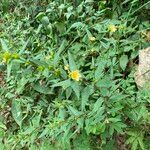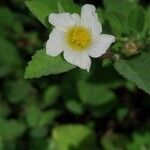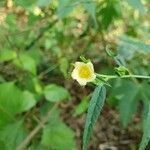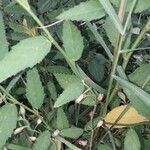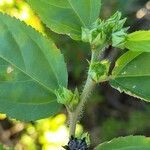Subshrubs or herbs erect, 1-2 m tall. Branchlets pilose or subglabrous. Leaves ± distichous; stipules filiform, 4-6 mm, often longer than petiole, usually persistent; petiole 4-6 mm, sparsely pilose; leaf blade ovate, oblong, lanceolate, or linear-lanceolate, 2-5 × 0.4-1 cm, both surfaces glabrous or sparsely stellate pilose, rarely with simple hairs adaxially, base obtuse, margin dentate, sometimes partly entire toward its base, apex acute or acuminate. Flowers solitary or paired, axillary, sometimes congested at stem apex. Pedicel 4-12 mm, pilose, articulate at middle. Calyx shallowly cup-shaped, connate in basal 1/2, ca. 6 mm, mostly glabrous, margins often ciliate, lobes 5, caudate. Corolla yellow, less often white or yellow-orange, 8-10 mm in diam.; petals obovate, 6-7 mm, ciliate, base attenuate, apex rounded. Filament tube ca. 4 mm, sparsely hirsute. Schizocarp nearly globose; mericarps (4-)6(-9), segmentiform-tetrahedral, ca. 3.5 mm, basally transversely ridged, side walls reticulate-veined, glabrous, apex beaked, ± extending into 2 awns, apically dehiscent. Seed trigonous, ca. 2 mm, glabrous except around hilum. Fl. winter-spring.
Erect suffrutex up to c. 1(3) m tall, glabrous or sometimes sparsely stellately hairy; stems usually much branched, green, woody only at the base. Leaf-lamina 2-6(10) x 0.5-1.5(3.8) cm, green, lanceolate or linear-lanceolate, occasionally ovate-lanceolate, apex acute, margin sharply and regularly serrate, base obtuse to rounded; petiole 2.5 mm long, pubescent; stipules usually longer than the petiole, linear. Flowers yellow, solitary or paired, axillary; pedicels 4-12 mm long. Calyx 6-8 mm long, membranous, glabrous, saucer-shaped, somewhat angular, divided to about the middle; lobes deltoid, caudate-acuminate. Petals 6-8 mm long, ciliate. Mericarps 5-6, c. 4 mm long, birostrate with a groove between the awns, reticulately striate and sulcate. Seeds smooth, glabrous except for a pubescent area around the hilum.
A herb. It grows up to 70 cm high. It has many branches. The leaf stalk is 4-6 mm long. The leaves are sword shaped. They are 2-5 cm long by 0.4-1 cm wide. They have teeth around the edge. The flowers are yellow. They occur in the axils of leaves. They are either singly or in pairs. The fruit is nearly round and 3-5 mm across.
Small shrub, up to 1(-3) m high. Leaves lanceolate, sharply serrate. Stipules 6-10 mm long. Flowers solitary or paired, pedicels 4-12 mm long. Mericarps 5 or 6, rugose, with 2 rigid pointed awns. Flowers yellow.
